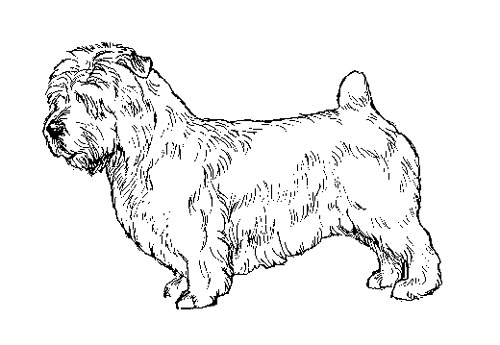Glen of Imaal Terrier
Terrier Group
The goals and purposes of this breed standard include: to furnish guidelines for breeders who wish to maintain the quality of their breed and to improve it; to advance this breed to a state of similarity throughout the world; and to act as a guide for judges.
Breeders and judges have the responsibility to avoid any conditions or exaggerations that are detrimental to the health, welfare, essence and soundness of this breed, and must take the responsibility to see that these are not perpetuated.
Any departure from the following should be considered a fault, and the seriousness with which the fault should be regarded should be in exact proportion to its degree and its effect upon the health and welfare of the dog and on the dog’s ability to perform its traditional work.
History
A native of Ireland's County Wicklow, the breed was named after the glen (valley) of Imaal. Although not very well known, the breed is nonetheless a very old one that has just simply been ignored. This scrappy terrier was developed as a game working dog to destroy vermin, especially badger.
The Glen of Imaal Terrier was recognized by the United Kennel Club on January 1, 1993.
General Appearance
This medium-sized terrier has a medium length coat, with a body that is longer than tall and close to the ground. It should move with a free, and not hackneyed, gait. The image of the breed is one of great strength, with the impression of maximum substance for the size of the dog.
Any departures from the standard are to be penalized relative to the degree of deviation from the ideal.
Scars, the result of honorable wounds, are not considered faults and are not to be penalized.
Characteristics
The active, agile Glen of Imaal is characteristically silent when working. In temperament, the breed is game and spirited, with great courage when called upon. Otherwise it is gentle and docile. It is known for its intelligence and is quick to learn.
Head
The head is fairly long, with a pronounced stop.
SKULL
Wide.
MUZZLE
Powerful, tapering in width from eyes to nose.
TEETH
A full complement of strong, regular, white teeth of good size meet in a scissors bite.
Serious Faults: overshot or undershot bite.
EYES
The medium size, round eyes are set well apart and are brown in color.
Fault: Light eyes.
NOSE
The nose is black.
EARS
Small, rose, or half-pricked when alert; thrown back when in repose. Full drop or prick ears are undesirable.
Neck
The very muscular neck is of moderate length.
Forequarters
The broad, muscular shoulders are well laid back.
FORELEGS
The short, well-boned forelegs are bowed.
Body
The body is deep and long, and longer than high. The topline is straight. The loins are strong. The chest is wide and strong, with well-sprung ribs.
Hindquarters
The strong, well-muscled hindquarters have good thighs and good bend of stifle.
HIND LEGS
The hocks turn neither in nor out.
Feet
The strong, compact feet have rounded pads. The front feet turn out slightly from the pasterns.
Tail
The well-set-on tail is strong at the root and carried gaily. Pups’ tails are customarily docked to half-length.
Coat
The breed is double-coated. The harsh-textured, weather- resistant outer coat is of medium length. The undercoat is soft. The coat may be tidied to present a neat outline and the natural "rough and ready" appearance, but should never be over-groomed.
Color
Acceptable colors include brindle, blue, and wheaten. The blue should not tone to black. Wheaten ranges from a light wheaten color to a golden reddish shade.
Puppies are usually born true to type in color, blue, wheaten, reddish. There may be an inky blue mask and a streak of blue down the back on the tail and on the ears. These darker markings clear with maturity.
Height & Weight
Maximum height for males is fourteen (14) inches (35.5 cm), measured at the withers. Bitches may be accordingly less.
Weight for males is thirty-five (35) pounds (16 kg). Bitches may be accordingly less.
Gait
Movement is free, covering the ground effortlessly with good drive behind. A hackney gait is not desirable.
Disqualifications
(A dog with a Disqualification must not be considered for placement in a conformation event, and must be reported to UKC.)
Unilateral or bilateral cryptorchid.
Viciousness or extreme shyness.
Albinism.
The docking of tails and cropping of ears in America is legal and remains a personal choice. However, as an international registry, the United Kennel Club is aware that the practices of cropping and docking have been forbidden in some countries. In light of these developments, the United Kennel Club feels that no dog in any UKC event, including conformation, shall be penalized for a full tail or natural ears.

Looking for a Dog?
Find a dog that will fit your family.
Note: The breeders on this list are not endorsed by UKC.
Revised May 1, 2017
©Copyright 1993, United Kennel Club
